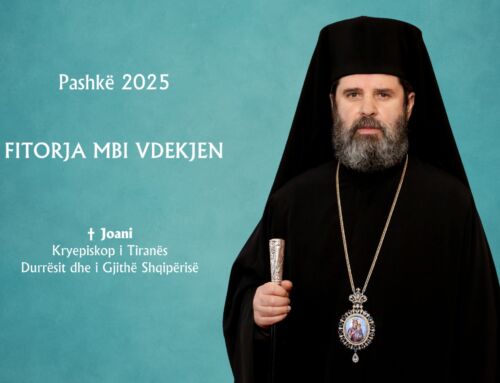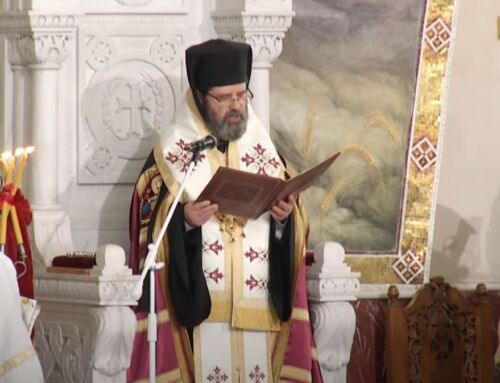
ORTHODOX AUTOCEPHALOUS CHURCH OF ALBANIA
Secretariat of the Holy Synod
Regarding the Master’s Paper
Of the Archimandrite Fr. Grigorios Frangakis
On “The Ecclesiastical Issue in the Ukraine”.
The Master’s paper of the Archimandrite Fr. Gregorios Frangakis – Chief Secretary of the Great Church of Christ, with the topic “About the Healing of the Ecclesiastical Issue in the Ukraine by the Mother Church of Constantinople. (The Issue of Ordinations)”, which was submitted recently to the Theological Faculty of Thessaloniki (AUTH) and was posted on the internet, also discusses the granting of Autocephaly to the Church of Albania in 1937. However, what is mentioned is inexact and indirectly misleading. The differences are obvious:
Bishop Visarion Xhuvani, who was ordained in 1925 and was self-proclaimed in 1929 as “Archbishop” of an Autocephalous Church, did not apply for an ekkleton, as Filaret is considered to have done. He asked for forgiveness, which was granted to him. Simultaneously, however, no acting position was bestowed on him in the Orthodox Church of Albania when she was proclaimed Autocephalous in 1937.
Bishop Agathangelos was ordained by Visarion on February 12th, 1929. He was defrocked together with all of the members of the Synod, as announced by the Encyclical of the Ecumenical Patriarchate “To the Pious Orthodox Pleroma in Albania” on February 25th, 1929. Therefore, Agathangelos did not receive ordination from a defrocked, excommunicated, and anathematized Bishop, as was the case with Epiphanius, nor did he become a Primate of an Autocephalous Church. In Albania, no group was ignored, as in the case of Metropolitan Onufriy together with at least 90 Bishops.
It is also worth noting that in the relevant Patriarchal and Synodal Tomos of Autocephaly, the Church of Albania is called “sister” three times and nowhere is referenced to as “daughter”, similarly all the local Orthodox Churches are called “sisters” three times and nowhere “daughters”, as is written in the Tomos of Ukraine. Most importantly however, peace and unity have been brought to Albania, in contrast to what has happened in Ukraine, with unpropitious consequences for all Orthodoxy.
Finally, in the Tomos of Ukraine the following is written: “In addition to the above, we declare that the Autocephalous Church in Ukraine knows as its head the most holy Apostolic and Patriarchal Ecumenical Throne, just as the rest of the Patriarchs and Primates also do”. A similar reference does not exist in the Tomos of Autocephaly of the Orthodox Church of Albania.
****
All the cases mentioned in the Master’s paper referenced to above as analogues (Bulgaria, Serbia, etc.) are a juxtaposition of dissimilar facts in relation to the ecclesiastical issue of the Ukraine. Through the course of the centuries, several schisms occurred in many local Churches due to various factors and conditions. According to the writer of the paper, the various cases are altogether considered as a single disease, which is called “schism”, requiring the same therapy. However, just as various diseases – tuberculosis, malaria, cancer, etc. – are each defeated by a different therapeutic treatment, likewise the same holds true to schism.
The case of Ukraine is similar to the Melitian Schism, as analyzed in the study of Metropolitan Vasilios of Smyrna, formerly of Anchialos, which was sent to us by the Ecumenical Patriarchate with its letter of response of February 20th, 2019. The correction of the Schism of the Melitians and the ‘by oikonomia’ integration into the Church of those invalidly ordained by Melitius comprised the following phases: a) repentance, b) laying on of hands by a canonical Bishop and prayer, according to the phrase of Saint Athanasios “it was decided… that those who were appointed by him to be restored to communion after being confirmed through a μυστικωτέρᾳ χειροτονίᾳ βεβαιωθέντας mistikotera hierotonia veveothendas (mystical, inaudible ordination)”[1] (with the simple laying on of hands each one was approved in their sacerdotal ranks), and c) the attainment of peace through the decision of a Pan-Orthodox Synod. This is a principle that is valid for the reincorporation of all similar schismatic cases into the Orthodox Church and determines an interesting exodos from the existing problem.
In general, it is accepted that the ordaining Bishop acts in the name of the Church, when he is within Her as “a steward of the sacraments of God”. Outside of Her, he is deprived of every sacerdotal grace and each holy act is invalid and inexistant.
The theory of the indelible priesthood, which has been adopted by the Roman Catholic world, (even if it is temporarily accepted as a working hypothesis), does not constitute an argument for the transmission of the grace and the validity of apostolic succession. Even if it is supposed that there remained imprints from the ordination, when the ordainer is cut off from the Church, defrocked, anathematized, and excommunicated, he becomes inactive and does not transmit any grace, (like an electrical device does not transmit any energy when it is cut off from the electrical current). Nor definitely does this that never occurred becomes as having occurred, existing, valid, through a simple administrative decision. This is exactly where the concern for the validity of the ordination of Epiphanius by Filaret is based.
Certainly, the Church as the fount of divine grace acts according to akrivia in certain instances and in other cases according to oikonomia, always with the purpose of concordance “to keep the unity of the Spirit in the bond of peace” (Eph. 4:3), in significant cases in a Pan-Orthodox Synod, in order that doubts do not exist.
The Church of Albania did not adopt a Russian point of view, on the contrary, she was the first who pointed out and condemned the use of the Holy Mystery of the Divine Eucharist for the imposition of the opinions of the Patriarchate of Moscow. She by no means doubted the right of ekkleton nor the need for the granting of Autocephaly in Ukraine. In the letter of response to the Ecumenical Patriarchate of March 19th, 2019 she proposed for the same procedure that led to the solution of the Melitian Schism by the First Ecumenical Synod to be applied. She expressed, as she ought, speaking the truth in love, reasonable dogmatic reservations referring to the process of the granting of Autocephaly, proposed, as did other Orthodox Churches, and continues to request that a Pan-Orthodox Synaxis be convoked, which in the Holy Spirit will normalize an ecclesiastical issue that afflicts the Orthodox people around the world.
The fundamental conviction remains that the Divine Eucharist, Apostolic Succession, and Synodality are the unshakeable foundation of Orthodox unity and that which is desired remains peace and the unity of Orthodoxy throughout the world.
Tirana November 15th, 2022
(From the Chief Secretariat of the Holy Synod of the Orthodox Autocephalous Church of Albania)
[1] Athanasius Theol., De decretis Nicaenae synodi Chapter 36, section 7, line 2 TLG Μυστικωτέρᾳ = mystically, in a low voice, secretly. For the meaning of the word μυστικωτέρᾳ in a liturgical context see A Patristic Greek Lexicon edited by G. H. Lampe D.D., Oxford at the Clarendon Press, 1961, pp. 894



